MAY 2024




MAY 2024



The Department of Jobs, Tourism, Science and Innovation acknowledges the Traditional Custodians throughout Western Australia and their continuing connection to the land, waters and community. We pay our respects to all members of Aboriginal and Torres Strait Islander communities and their cultures, and to Elders past and present.
James Price Point CREDIT: Ben Charles (Unsplash)
Western Australia is the nation’s economic powerhouse. Abundant with natural resources, we are a leading energy, mining and minerals processing region with considerable reserves of iron ore, natural gas, critical minerals and solar and wind power.
Our thriving investment and trade ecosystem, built around a diverse range of industries, underpins the State’s growth, supporting Western Australia to become one of the fastest growing developed economies over the past 20 years.
Western Australia’s existing manufacturing base is dynamic and diverse, supported by original equipment manufacturers, component assemblers, and a flourishing research and development ecosystem. Our resource sector’s embrace of autonomous and remote technologies has spurred remarkable advances, setting a precedent for other industries to innovate and excel.
The Western Australian Government recognises that growing advanced manufacturing capability is critical to increasing the competitiveness and value-adding potential of Western Australia’s export industries. Our commitment to advanced manufacturing is crucial in positioning Western Australia at the forefront of the global energy transition. By innovating new processes, automating operations, and developing revolutionary products and materials, we are charting a path towards a cleaner energy future.

We are cultivating an environment where advanced manufacturing thrives, bolstering sectors that are key to our net-zero goals. Our investments in the energy, defence, and space sectors, along with our robust research and development ecosystem, underscore our ambition.
Western Australia is set to emerge as a global leader in green energy, with our skilled workforce spearheading the development of future energy technologies, including battery production, standalone power systems, and hydrogen electrolysis.
The Western Australian Government, building upon the Diversify WA economic development framework and the release of Future State: Accelerating Diversify WA, is committed to harnessing our unique strengths. We are nurturing our core industries while expanding into new sectors, to strengthen the opportunities for international investment.
By endorsing local companies to manufacture here in Western Australia, to add value, and to compete globally, we are not just investing in today—we are shaping the future. This is a transformative time for Western Australia, and we look forward to welcoming you and your business to our extraordinary State.
Hon Roger Cook MBA MLA Premier; Minister for State and Industry Development, Jobs and Trade; Public Sector Management; Federal-State Relations.
The Western Australian Government’s longterm vision is for the State’s industries to be transformed into a highly integrated, collaborative and export-focused sector, supported by strong local advanced manufacturing capability and resilient domestic and global supply chains. Unlocking new advanced manufacturing opportunities requires a targeted, holistic wholeof-government approach. Our government, in collaboration with the Australian Government, is working to create a business environment that is conducive to attracting investment into advanced manufacturing opportunities.
We are actively establishing strong policy and transparent regulatory frameworks to increase the confidence of businesses wishing to invest in Western Australia. This government led action aims to remove barriers to the uptake and commercialisation of new innovations and technologies.
Our commitment to strong trade relationships, supported by our Invest and Trade WA international network, continues to strengthen our global engagement and elevate the participation of Western Australian businesses in global supply chains.
Our investment in a well-skilled, agile and highly productive workforce will reduce the risk of skills shortages, and enables the transferability of labour, particularly to meet the needs of our new and emerging industries.
Western Australian manufacturers, leveraging our innovative and technological prowess, abundant resources, and strategic positioning, have become integral contributors to domestic and global supply chains. As we deepen our engagement in advanced manufacturing, our emphasis remains on sustainability, economic diversification, and creating high valued jobs and opportunities relevant to the evolving global landscape.
We are enhancing our advanced manufacturing capability to navigate challenges and capitalise on our advantages. This includes fostering developments in areas such as battery production, stand-alone power systems, hydrogen, and wind turbine manufacturing, which are pivotal to our energy transition and net-zero objectives.
With both government-led and private sector collaborations propelling our momentum, Western Australia is paving the way to lead advanced manufacturing on the global stage.
Hon Stephen Dawson MLC Minister for Emergency Services; Innovation and the Digital Economy; Science; Medical Research; Minister Assisting the Minister for State and Industry Development, Jobs and Trade.

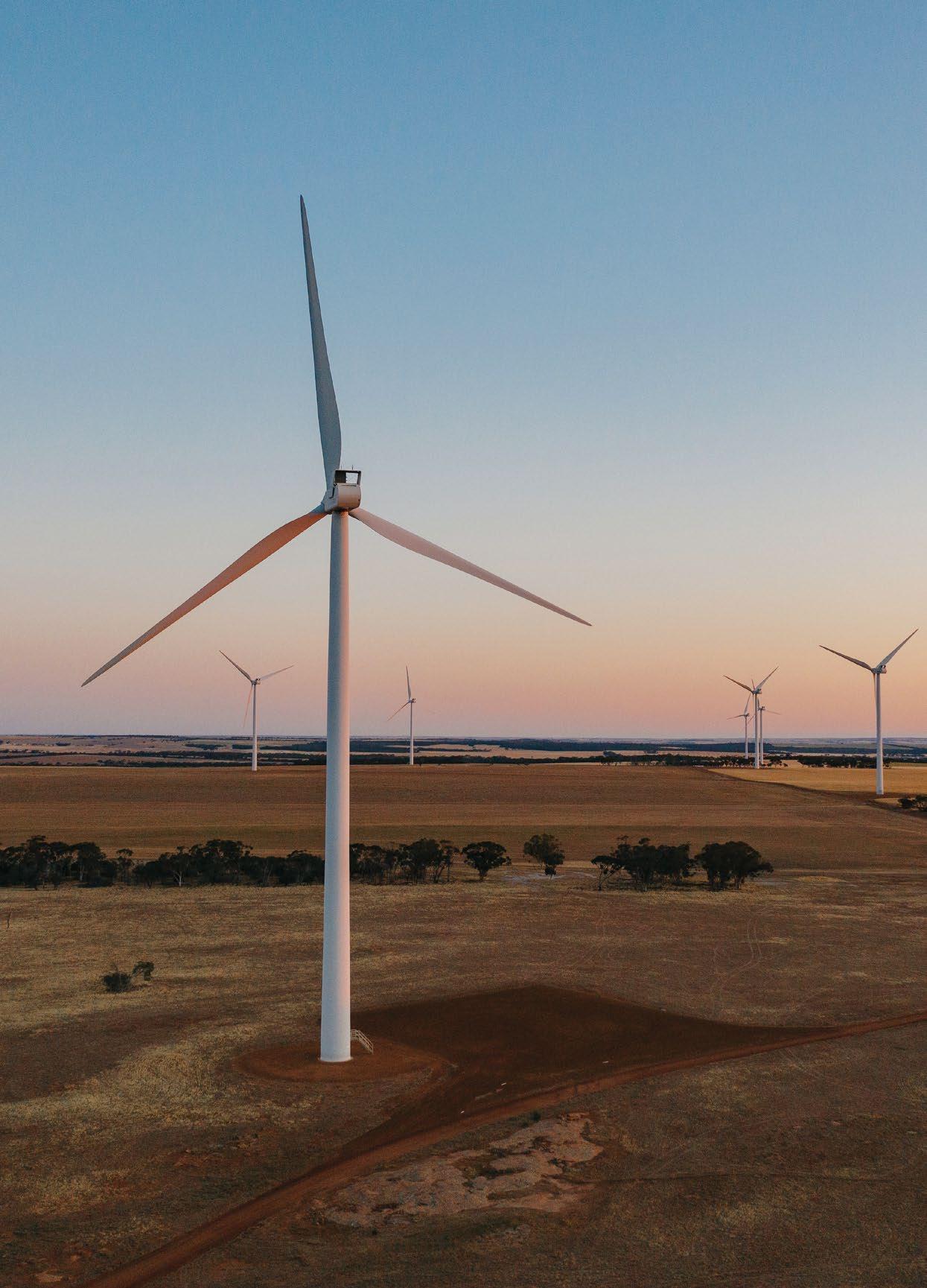 Merredin Collgar Wind Farm
CREDIT: Tourism WA
Merredin Collgar Wind Farm
CREDIT: Tourism WA
With a foundation built on our resource sectors of mining and primary industries, Western Australia is primed to lead advanced manufacturing. Our resources sector has driven significant change in the development and uptake of autonomous and remote technologies, and many other industries continue to innovate by using these technologies. Western Australia is in a unique position to build on the successes of our resource sectors with the transfer and interoperability of both skills and technologies to support the growth of new and emerging advanced manufacturing opportunities.
Western Australia is globally recognised as a major minerals exporter. Our highly skilled and experienced workforce, nurtured by decades of industrial experience, creates solutions for the world’s major oil, gas, chemicals, mineral processing and defence operations, health and medical life sciences, space industries, mining and mining equipment, technology and services (METS).
Western Australia leads the world as a top supplier of lithium and a major producer of rare earth elements. Complementing this is our already internationally recognised primary industries sector, including value-added food and beverage production which features a diverse range of high-quality products. Combined, these sectors enable Western Australia to capitalise on new and emerging trends and opportunities by harnessing advanced manufacturing capabilities to support innovation in these sectors.
Western Australia boasts a network of global leaders and dynamic enterprises, harmonising tradition with modern innovation. Over the last five decades, we have adeptly integrated hightechnology and knowledge-intensive inputs into our manufacturing processes, ensuring agility, digital connectivity, optimising automation to compete competitively on the global stage.
Western Australia has established robust policy and regulatory mechanisms to continuously improve support for investors and remove barriers to the uptake and commercialisation of new innovations and technologies.
Our established infrastructure, featuring strategically connected port, rail, road and other major services such as power, gas, water and telecommunications, ensures efficient pathways to market so our industries remain competitive.
Our low sovereign risk and political stability, underpinned by sound financial management and economic strengths, create a secure environment for advanced manufacturing to thrive and evolve. Enriched with research institutions, technological hubs, skilled workforce and industry leaders, Western Australia possesses what’s required to be a prominent advanced manufacturing destination.
Western Australia is primed to play a central role in developing new products, processes and solutions through advanced manufacturing to respond to global challenges. By fostering our technological and innovative prowess and our key strategic advantages, we will enable the growth of our State’s priority sectors:
• Energy
• Defence Industries
• Mining and Mining Equipment, Technology and Services (METS)
• Space Industries
• Primary Industries
• Health and Medical Life Sciences.
Western Australia has long been a secure and stable investment and trade partner, demonstrated through sustained economic prosperity and a vibrant export economy. Our strategic location in the Indian Ocean region offers unparalleled access to Asian markets, and our focus on innovation and sustainability positions Western Australia as an attractive hub for investors.
Western Australia accounted for 19% of Australia’s business investment in 2022-23, with business investment in the State rising 13% to $53.4 billion.
Manufacturing in Western Australia bolstered the economy with a $18.4 billion contribution in 2022-23, accounting for 4% of the State’s gross state product (GSP).
Western Australia’s real gross state product (GSP) rose 3.5% in 2022-23.
Western Australia’s $445.3 billion economy was 17.4% of the Australian economy.
Advanced manufacturing contributes to more inclusive and sustainable industrialisation. Value-adding clean manufacturing, along with automation and digitisation, contributes to the State’s energy transition towards a low-carbon economy as well as creating future-proofed jobs and economic growth.
Western Australia’s transition to clean energy spans many industries and is supported by a strong foundation of strategic frameworks to enable growth and improve access to reliable energy.
Across the energy sector, businesses of all sizes are establishing ambitious emission reduction targets, delivering innovative renewable energy projects, scaling-up critical minerals and battery storage capability, implementing low-carbon technologies, and exploring opportunities to capture, sequester and utilise carbon.
Through these measures, Western Australia’s energy sector is continually striving to ensure the delivery of innovative and sustainable solutions that meet the needs of both local and global energy users.
49.2%
Iron ore accounted for 49.2% of the value of Western Australia’s minerals and petroleum sales in 2022-23, with iron ore exports value recorded at $123.2 billion in the same financial year.
Western Australia is the 3rd largest rare earths supplier in the world, accounting for 6% of global supply in 2022 with the estimated value of the State’s rare earths sales at $505 million in 2022-23.
62%
Western Australia’s gross state product (GSP) per capita was $157,390 in 2022-23, 62% above Australia’s gross domestic product (GDP) per capita of $97,435.
Western Australia’s Australian Marine Complex (AMC) is the State’s shipbuilding and sustainment industrial precinct and Australia’s shipbuilding prime. The AMC is one of only two naval shipbuilding locations in Australia and is currently utilised by over 150 local small and medium enterprises delivering manufacturing, fabrication, assembly and maintenance requirements of the marine, defence, energy and resource industries. The AMC delivers capabilities to the navies of Australia’s allied partners, including the United States and United Kingdom.
$257.7bn
Goods-producing industries accounted for 58% ($257.7 billion) of Western Australia’s GSP in 2022-23, including:
• mining (45% or $200.0 billion)
• construction (5% or $22.8 billion)
• manufacturing (4% or $18.4 billion)
• agriculture, forestry and fishing (2% or $11.1 billion).
$421m
Spanning more than 250 related businesses, Western Australia’s defence industries contributed $421 million to the State’s economy in 2021-22, an increase of 13% from the previous year.
100
Home to over 100 resource and energy businesses, attracting major international players and fostering a hub of industry innovation.
22
22 of the top 100 global mining and METS companies are headquartered in Western Australia and a further 55 are operating in the State.
30%
Approximately 30% of all ASX listed companies find their home in Perth.
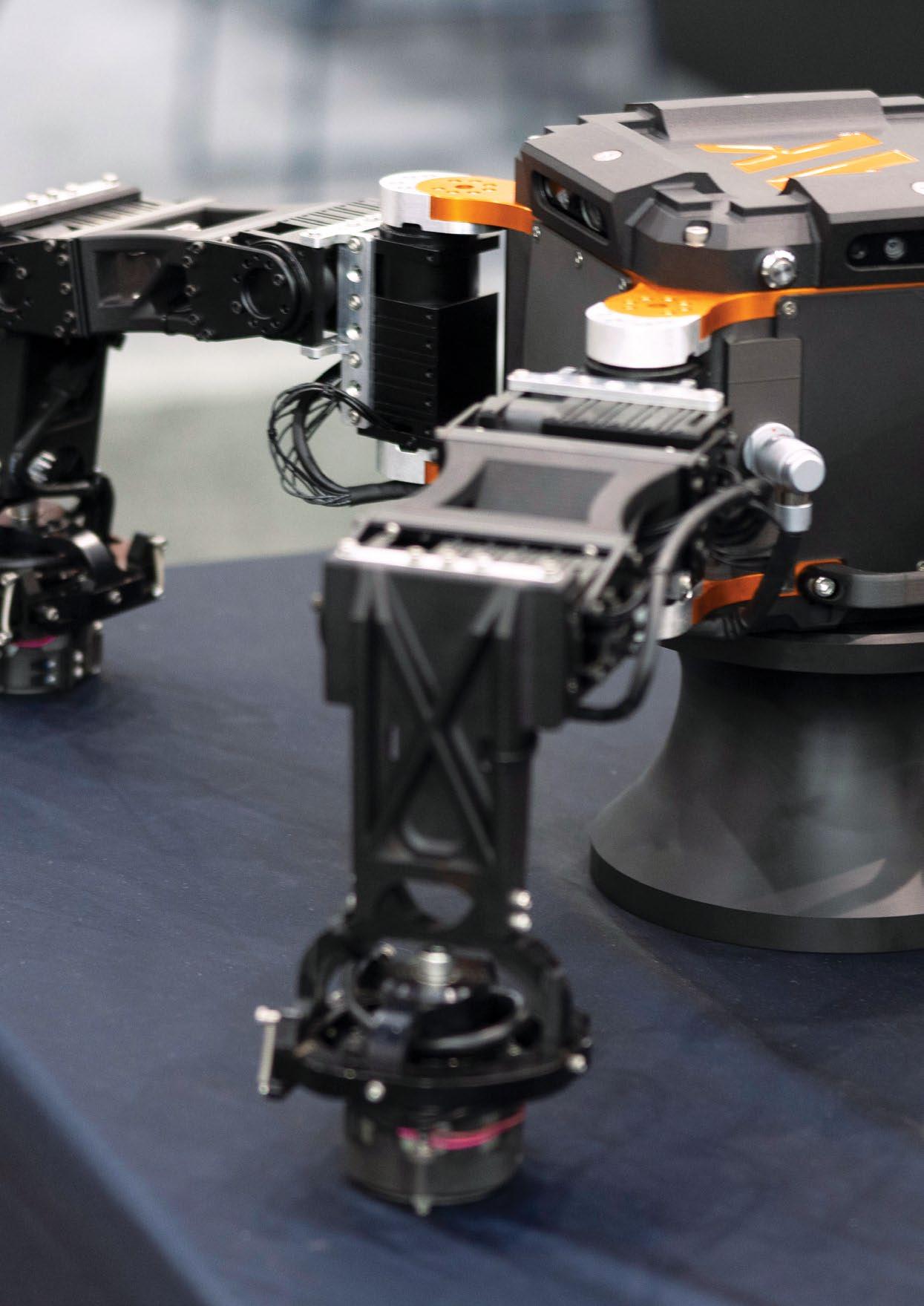 Magneto Robot CREDIT: Nexxis
Magneto Robot CREDIT: Nexxis
Investing in Western Australia’s advanced manufacturing is not just a business decision; it is an investment in an integrated ecosystem renowned for its leading-edge solutions.
• Supportive investment and trade environment, with grants and incentives that encourage growth and innovation.
• Strategic location provides access to crucial markets, making us a gateway for businesses aiming for global impact.
• Modern infrastructure that equips businesses with the resources they need to succeed.
• Large scale demand management and water supply initiatives to meet the needs of industries and businesses.
• Established electricity networks featuring reliable and secure renewable energy sources and a Western Australian Government target to achieve net zero emissions by 2050.
• Versatile and skilled workforce with diverse expertise.
• Abundant natural resources, such as gas, solar and wind, fuelling both traditional and advanced manufacturing sectors.
• Innovative ecosystem boasting world leading research institutions, state-of-the-art facilities, and collaborative platforms.
• Robust and transparent regulatory frameworks ensure projects meet the highest environment, social and governance standards.
• Lead Agency Framework, designed to ensure proponents can be guided effectively and efficiently through approvals processes.
Established in Western Australia, Nexxis leveraged the State’s strategic advantages to transform inspection and maintenance in gas, mining, and manufacturing sectors.
Their innovative Magneto robot, capable of adjusting its form to access tight spaces and electromagnetics to navigate complex environments, revolutionised safety standards by minimising the need for humans to work in hazardous conditions such as confined spaces and at heights.
This robotic platform is pivotal in advancing data capture and digital workflows. Nexxis overcame
financial and market growth obstacles, utilising government grants and incubation spaces, establishing their technology internationally.
In collaboration with Alcoa, Nexxis developed the Powertrain, a robotic system designed to traverse pipework and digitally scan pipe internals allowing fact conditions assessments.
Nexxis exemplifies how small and medium enterprises (SMEs) in Western Australia can become global leaders through committed research, development and innovation, strategic partnerships, and advanced manufacturing technologies.

Western Australia is rich in energy resources, with a mix of coal, gas and renewable energy sources available. Our vast natural gas reserves are supplemented by world-class solar and wind resources, creating the potential for a diversified and sustainable energy portfolio.
As we adopt new energy technologies, we’re not only securing our energy supply but also paving the way for diverse economic opportunities. The energy transition offers significant potential for the development of new industries and the production of new renewable and low emission technologies.
With a focus on advanced manufacturing, Western Australia is primed and positioned to play a central role in the global market for battery minerals production, hydrogen electrolyser manufacturing, and the production and processing of essential materials like lithium, nickel, rare earths, green iron and steel, and aluminium derivatives, along with innovative sectors such as wind turbine production.
Strategic energy storage solutions, such as fast response and long-duration storage, are key to our ability to manage a high renewable energy contribution to our electricity systems. These technologies not only protect against fluctuations but also allow Western Australia to fully utilise our renewable assets.
By effectively storing clean energy, Western Australia can provide a low emissions power supply that meets the high demands of our growing economy and the needs of our innovative manufacturing sector, while also reducing the State’s carbon emissions.
• Renewable energy: emphasising the transition to cleaner energy sources, we are investing heavily in solar, wind, and energy storage projects.
• Hydrogen energy: focusing on delivering decarbonisation and diversification objectives and a pathway towards achieving the State’s aspirations to develop a renewable hydrogen industry. Creating renewable hydrogen hubs in the Pilbara and Mid West is projected to generate about 2,000 skilled and semi-skilled jobs across the State.
• Battery technology: leveraging our vast reserves of lithium and other essential minerals, the Western Australian Government is developing hubs for advanced battery manufacturing and technology.
• Carbon capture utilisation and storage (CCUS): with a focus on opportunities for industry to collaborate and develop CCUS projects that optimise investment and create jobs in industries whilst harnessing our State’s decarbonisation goals.
• Energy efficiency: with a focus on sustainable growth, we are championing projects that aim to optimise energy productivity, reduce wastage, and enhance overall efficiency.
• Strategies
- Energy Transformation Strategy Stage 2 (2021-2025) focuses on modernising our energy landscape with renewable integration and technological innovation for a low-carbon future.
- Sectoral Emissions Reduction Strategies (SERS) outline key modeling results that support policy initiatives across various industries and encourage investments in new low-emission technologies.
- Renewable Hydrogen Strategy defines strategic areas of focus for the development of the State’s hydrogen industry including a roadmap.
- Battery and Critical Minerals Strategy outlines priorities and actions to enhance the State’s industry competitiveness by growing participation in global supply chains, promoting investment opportunities, supporting certification of battery minerals, drive the uptake of battery storage within industry and communities, and, develop local workforce capability.
• Legislation: passing of the Petroleum Legislation Amendment Bill 2023 and the Petroleum and Geothermal Energy Safety Levies Amendment Bill 2023 that provides for CCUS.
• Infrastructure: to transform the State’s electricity infrastructure and enable the reliable supply of low emissions electricity, the South
West Interconnected System (SWIS) Demand Assessment highlighted the potential change to electricity demand over the next 20 years. An initial $126 million investment has enabled Western Power to commence planning and scoping required for the first stage of network augmentation. The investment will enable the procurement of long-lead items and ensure vital network upgrades, ensuring the network can respond to future energy demands and industry growth. A further $708 million commitment has been made by the Western Australian Government to upgrade the State’s main electricity network and unlock renewable energy generation opportunities.
• $160 million for industrial lease incentives to attract large-scale clean industries projects.
• $60 million in the Investment Attraction Fund for a New Energies Industries grants round, driving job creation in new energy industries.
• $74 million into a range of initiatives to further Western Australia’s net zero ambitions, as part of its Sectoral Emissions Reduction Strategies (SERS) process.
• Wind Turbine Manufacturing Initiative (WTMI): This initiative seeks to enhance the participation of local businesses in wind turbine manufacturing and servicing supply chains.
Following an independent full feasibility study, the Government has allocated $8 million in WTMI funding to support the development of a local wind turbine manufacturing industry.
An industry support program will assist Western Australian businesses to build capacity and capability to manufacture and service wind turbine components and power up Western Australia’s energy manufacturing sector.
With demand for renewable energy set to grow significantly and given Western Australia’s strong wind resources, unlocking further opportunities for local businesses in the wind energy supply chain will help to create local jobs and strengthen the economy.
Western Australia’s defence industries are competitive, have a long history of success, are resilient and are at the forefront of the next generation of defence technologies and innovation. Our State is well placed to draw on cross-sector expertise to rapidly boost advanced manufacturing capability across naval shipbuilding, sustainment and maintenance, and uncrewed and autonomous vehicles.
Western Australia is home to Australia’s largest naval base (HMAS Stirling), key Royal Australia Air Force and Australian Army bases, and the Australian Marine Complex (AMC). As a worldclass centre of excellence for manufacturing, fabrication, assembly, maintenance and technology development, the AMC services a range of sectors such as defence, oil and gas, and resources.
The AUKUS partnership, a trilateral security pact between Australia, the United Kingdom, and the United States, is making strides in information sharing and critical defence technologies, including undersea robotics, quantum technologies, artificial intelligence (AI) and autonomy, cyber capabilities, hypersonic weapons, and, electronic warfare.
Western Australia will lead Australia’s AUKUS nuclear-powered submarine program, building on its submarine heritage. This initiative will start with visits from United States and United Kingdom submarines via Submarine Rotational Forces –West (SRF-West), setting the stage for Australia to acquire and construct its own sovereign fleet to be based from HMAS Stirling. With hundreds of thousands of components, these new submarines will present a unique opportunity for Western Australian companies to contribute not only to the construction and sustainment of Australia’s new fleet but to the supply chains of partner nations.
Our State’s marine industry is equipped to construct, sustain, and maintain the next generation of naval vessels announced in the 2024 Enhanced Lethality Surface Combatant Fleet Review, including General Purpose Frigates and Large Optionally Crewed Surface Vessels at the AMC. With initiatives like the Defence Science Centre (DSC), Western Australia’s defence industries are advancing scientific research, technological upgrades, and innovation.
• Naval shipbuilding: with an emphasis on delivering a continuous shipbuilding program from the AMC for the future fleet for the Royal Australian Navy and Australian Border Force, including future sustainment of the fleet.
• Nuclear-powered submarine sustainment: development of infrastructure, industry, workforce, regulatory and security frameworks, and innovation to safely support both visiting United States and United Kingdom nuclearpowered submarines under SRF-West, and a future sovereign fleet based from HMAS Stirling.
• Technological innovation: investment in cutting-edge technologies such as robotics, automation, and cyber-security to meet modern defence needs.
• Skilled workforce development: building expertise to ensure a workforce ready for the evolving defence landscape.
• Commercial-Defence synergy: promoting dual-use technologies, innovations, skills and knowledge that serve both commercial and defence sectors for greater resource efficiency.
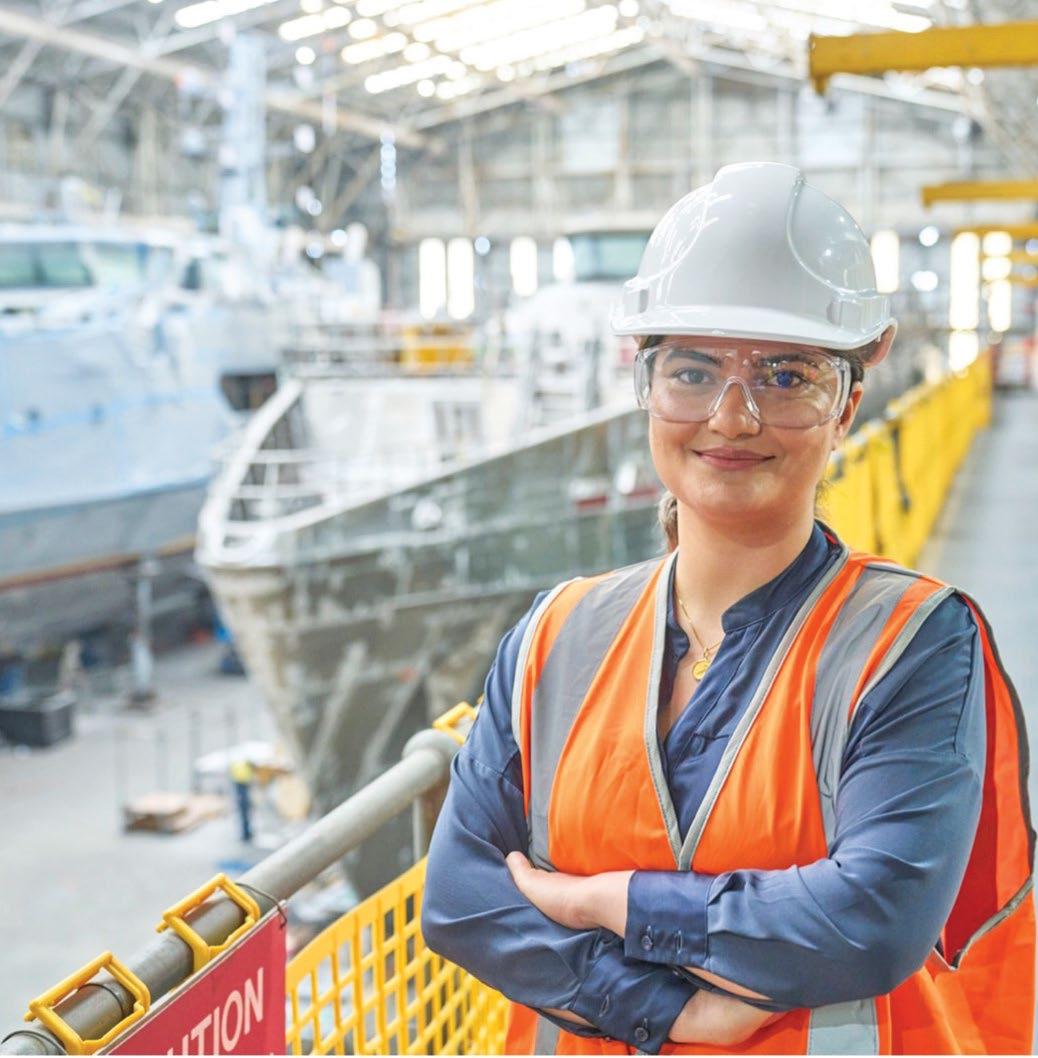
• Infrastructure: strategic upgrades and investments in facilities such as the AMC, ensuring infrastructure meets current and future defence demands.
• Strategic partnerships: embracing collaborations including the AUKUS partnership to enhance technological exchange and defence project cooperation.
• Investment in skills and technology: skills development for the workforce and investment in advanced manufacturing technologies.
 Australian Marine Complex Henderson
CREDIT: Austal
Australian Marine Complex Henderson
CREDIT: Austal
Austal, a leading global shipbuilder and one of Western Australia’s top exporters, specialises in creating high-performance vessels for defence, commercial, and passenger sectors. As part of a strategic shipbuilder pilot announced in November 2023, Austal will construct the Army’s Landing Craft Medium and Heavy (Littoral Manoeuvre Vessels) from the AMC. To underpin this pilot, Austal and Department of Defence will enter into a Heads of Agreement, marking the beginning of a long-term partnership and the start of negotiations for a strategic shipbuilder agreement to build the Navy’s future surface fleet from Western Australia.
In 2003, the company transformed its operations to utilise advanced computer enabled modular manufacturing activity. In the 20 years since, Austal has continued to increase value-adding activity in its facility to develop new vessels that meet the evolving needs of the defence industry as well as boost the advanced manufacturing capacity and capability of those businesses supporting it.
The facility’s advanced manufacturing processes include automated parts cutting and labelling, extruded parts processing so that there is almost no measuring, cutting or material processing through the remaining fabrication phases, automated welding, cobots, 3D printing and remote test labs. Tangible benefits include removing essential non-value add tasks by reducing the number of steps in a task and an increase productivity per m2 of workshop floor space.
In 2023, Austal went live with a 4-year Digital Twin Program, significantly increasing data capture and control across datasets. In addition to enhancing performance in procurement, modular 32 build, system assembly and testing phases, several simulation tools are used for preproduction design. Austal uses Machine Learning utilising Bayesian optimisation with DeepMorpher to significantly reduce the number of evaluations to generate an optimised hull form. This aligns with the company’s drive to reduce GHG emissions through advanced hull design. Austal is also exploring the use of advanced materials to improve strength and fatigue properties, whilst optimising weight. The majority of Austal’s 700-strong Western Australian workforce is directly involved in advanced manufacturing across technology, design, fabrication, support services, and sustainment.
Austal provides training in advanced manufacturing capability through exposure to equipment automation and digital tools, and awareness of integration between digital twin and final product at early career stages. The training includes technical training at TAFE, access to the vessel 3D model for electrical installation and further development to attain higher technical skills on all Austal electrical and automation systems.
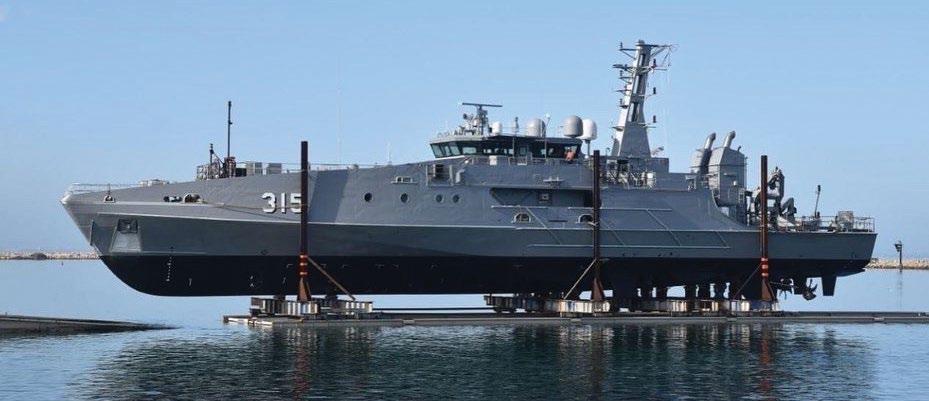
Western Australia’s rich mineral deposits are more than just a resource; they’re a key pillar of our economy and a catalyst for innovation. The production of key commodities, including iron ore, lithium, alumnia, gold and nickel has led to an increase in the value of Western Australia’s mining sector over the last two decades.
Our mining industry is at the forefront of global technological transformation, using advanced manufacturing capabilities to innovate and design new systems that improve productivity, safety and sustainable outcomes. With a seamless integration with the mining equipment, technology, and services (METS) sector, together, they form a dynamic ecosystem that not only drives economic growth but also pioneers responsible and sustainable mining solutions.
Western Australia is the location of choice and home to global mining and METS organisations’ headquarters and operations. We are the largest exporter of minerals and petroleum products in Australia and this accounts for a significant proportion of the world’s minerals and petroleum products. The METS sector in Western Australia
is estimated to account for about 30% of the national industry, adding an estimated $27 billion to the State’s economy in 2018. In 2022-23, Western Australia had 134 high-value, exportoriented mining projects and 15 major mineral processing operations.
As the world’s needs for green energy and advanced technology grow, our abundant reserves of battery minerals such as lithium, nickel, vanadium and rare earth metals become increasingly vital. Western Australia’s local mining sector leverages cutting-edge manufacturing to design new systems that enhance productivity and sustainability, particularly in remote operations and automation.
Major players in our mining sector are actively working to reduce carbon emissions across their operations, including transitioning their rail and vehicle fleets to cleaner energy sources. Advanced manufacturing techniques are central to these efforts, enabling the development of electrification options that are crucial for energy efficiency and sustainable outcomes throughout the manufacturing process.
22 of the top 100 global companies are headquartered in Perth and a further 55 global companies are operating in Western Australia.
Western Australia boasts over 400 autonomous haul trucks.
More than 50 autonomous drilling rigs are in operation across the State’s mine sites.
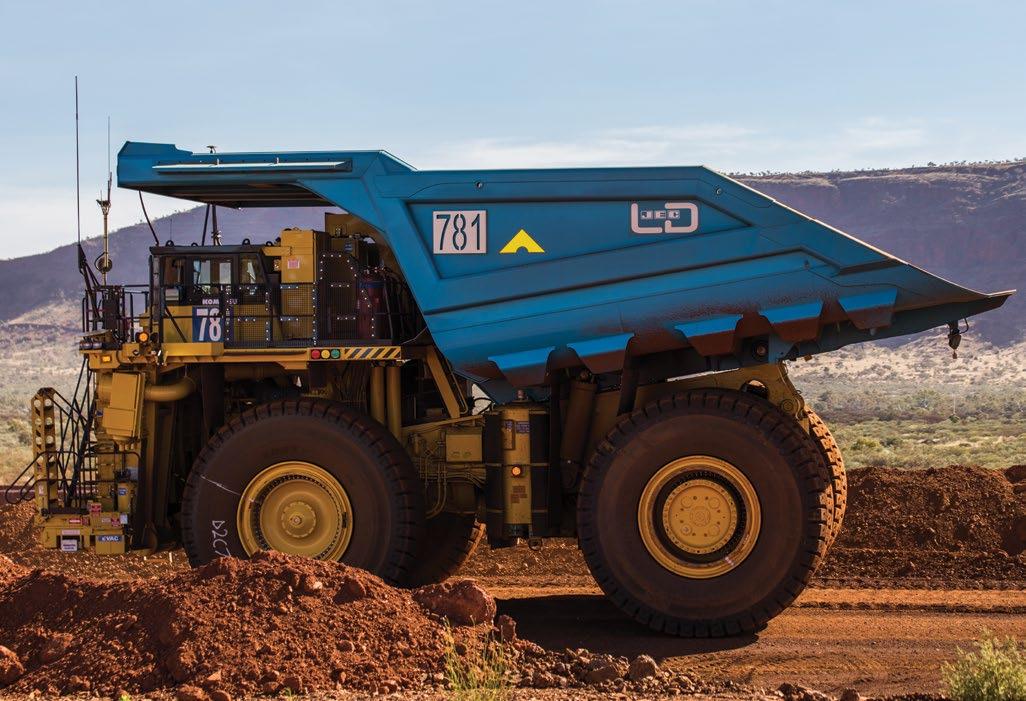
• Sustainable mining practices: adoption of sustainable and responsible mining practices to minimise environmental impact and ensure safe operations.
• Driving innovation: strong focus on technological advancements to enhance safety and efficiency in mining operations, including the Minerals Research Institute of Western Australia’s METS Innovation Program that seeks to broaden support for research projects led by METS organisations servicing Western Australia’s mining industry.
• Research and technology transfer: to optimise the transfer of technology across sectors enabling current and growing leading edge technologies to provide economic benefits to Western Australia.
• Strengthening global leadership: developing and exporting commodities essential for modern technologies.
• Sustainable mining: through strategic policies aimed at environmental conservation, decarbonisation, and technological advancement.
• Research and development: to propel the METS sector and maintain global competitiveness.
• Supporting initiatives: that promote safety, efficiency, and innovation across the mining industry.
• $3 billion in concessional financing: secured from the Australian Government for projects that expand, modernise and decarbonise Western Australia’s electricity grids.
Western Australia has more than 60 years’ experience in the space industry and is emerging as the Southern Hemisphere’s global hub for space operations, exploration and technology transfer. Western Australia’s unique geographical features, including dry environmental conditions, radio quiet zones, and clear skies, make it a prime location for major space projects such as the Square Kilometre Array in the Mid-West Region and civil and defence space infrastructure supporting critical global space activities.
More than 130 international and Australian businesses operate in space and space-related services in Western Australia, creating an innovative and thriving ecosystem. Investment in technologies such as artificial intelligence (AI), machine learning, robotics, remote operations, satellite design and manufacturing, satellite communications, space situational awareness and data analytics will support the ongoing growth of the space industry in our State. Additionally, the demand for advanced materials, electronics, and other components in space technology and exploration provides an opportunity to increase Western Australia’s proficiency in areas such as precision engineering, materials science, and electronics.
The burgeoning space-related activity in Western Australia indicates a growing demand for space technology manufacturing. This opens significant opportunities for new manufacturers in the State, further cementing our role as a global leader in the space industry.
• Space technology: development and manufacturing of spacecraft, rovers and payloads.
• Ground infrastructure: manufacture, construction and development of next generation ground infrastructure for space activities.
• Downstream application: increased utilisation of space data, services and technologies.
• Robotics, automation and remote operations: leverage the State’s world leading robotics, automation and remote operations technologies for space applications.
• Investment: in space industry infrastructure, research facilities and projects.
• Collaboration: with international space agencies and organisations to leverage global expertise and resources.
• Creation of a supportive environment: for space industry start-ups and innovation.
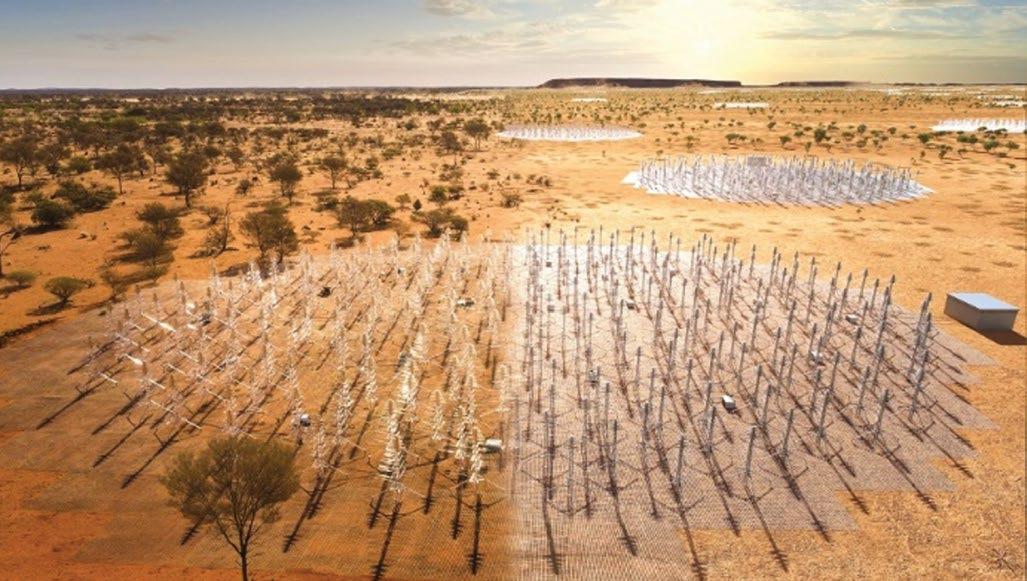
AVI is a Western Australian owned and operated company that specialises in the bespoke design, development and manufacturing of specialised communications solutions and componentry for harsh, remote and critical environments, AVI’s robust hardware and agile technology solutions are used in the most sensitive aerospace, military, mining, transport and security applications, all requiring trusted zero-fail operational performance. AVI is already powering some of the biggest robots in the world, providing capabilities for autonomous vehicles and networked battle systems.
AVI is advancing its capabilities through manufacturing new satellite communication payloads which are due to be tested in Low Earth orbit in 2024. AVI is also building up to 12,000 Power and Signal Distribution SMART boxes (Small Modular Aggregation RFoF Trunk) that will provide electrical power to the Square Kilometre Array-Low telescope’s 131,072 antennas and collect signals received for processing.
The Binar spacecraft, entirely designed and assembled in Western Australia, represents a cost-effective solution for space exploration. Additionally, the collaboration with Nova Systems has led to a cuttingedge new Space Domain Awareness facility. The facility features a state-of-the-art radar system to track satellites and space debris. The initiative underscores the advanced electronics and software systems being developed in Western Australia.
Western Australia is internationally recognised as a leading producer of premium quality, safe and certified raw agrifood and beverage products. Our well-established primary industries sector contributes more than $10 billion a year to Western Australia’s economy.
Western Australia’s primary industries are pivoting towards innovation and sustainability. Combining traditional practices with cutting-edge technologies, these sectors are advancing towards sustainable and efficient production, ensuring resilience and growth. This transformation is not only enhancing resilience and growth but is also instrumental in driving our economy forward. Targeting value added food and beverage production will increase our State’s primary industries sector output, capture greater value for our agricultural production, and meet increasing consumer demand for premium quality, certified agricultural products both domestically and internationally.
Advanced manufacturing plays a key role in the transformation, boosting productivity and efficiency. From food and beverage to forestry, the adoption of sophisticated manufacturing technologies is enabling Western Australia to produce high-quality, sustainable products.
This shift towards advanced manufacturing is not just about economic growth; it’s also a strategic move towards decarbonisation, reflecting Western Australia’s commitment to environmental stewardship and sustainable development.
Western Australia boasts strong freight connections and supply chain logistics, access to a highly skilled workforce, sustainable land use, water resource management, food security, and, reliable, clean and safe water sources. Combined, these provide a pristine green, clean environment that enables a broad range of agricultural production and a significant opportunity for Western Australian food manufacturers to meet a growing global demand for premium products.
Central to this innovative drive is the Western Australian Government’s Sustainable Innovative Food Technologies (SIFT) Centre located in the Food Innovation Precinct Western Australia (FIPWA) Peel Business Park. Another component is the Food Industry Innovation (FII) Program that focuses on uniting premium and value-added food and beverage producers to overcome growth
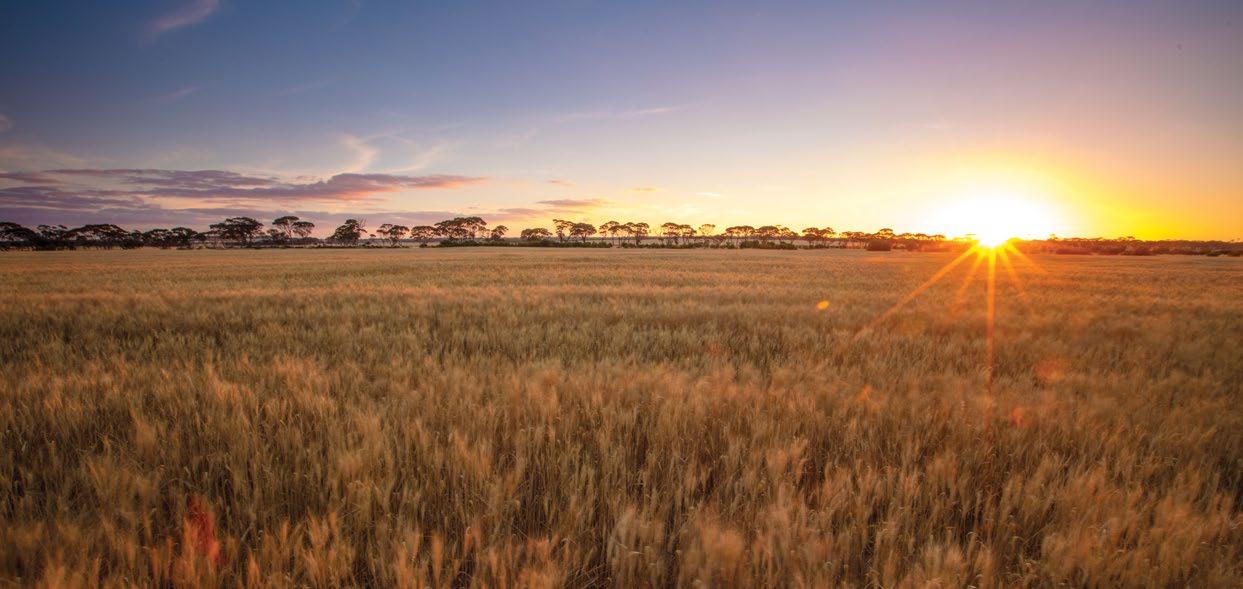
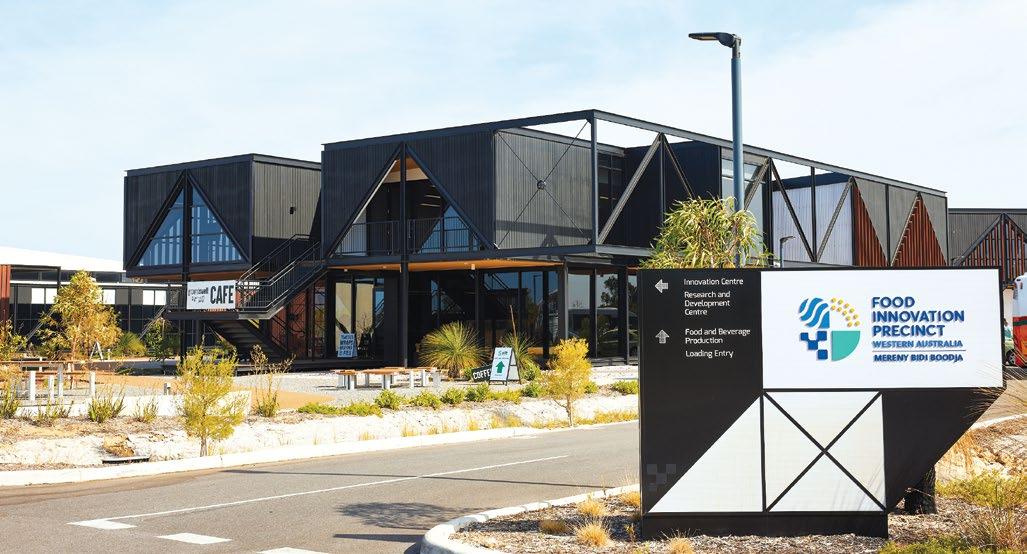
barriers through innovation, productivity and market development.
The program underscores the importance of value-added production in economic growth and job creation within the advanced manufacturing sector. For instance, the State-funded SIFT Centre within FIPWA enables producers to develop, test and produce new products using advanced manufacturing technologies. This pilot plant is pivotal in boosting food and beverage manufacturing capacity and capability in Western Australia, allowing businesses to innovate and meet market demands before scaling up their own production.
• Agriculture methods: adoption of sustainable and technology-driven practices in agriculture and fisheries.
• Sustainable forestry: advancing practices to balance ecological health with economic gain.
• Export capabilities: emphasising value addition to primary produce, such as through processing and market expansion.
• Industry development plan: The Primary Industries Plan 2020-2024 supports increasingly sophisticated and globally competitive primary industries that make a significant contribution and create prosperity across Western Australia.
• Policies: implementing policies that support sustainable farming and fishing practices.
• Research: investing in research and technological advancements to increase yield and quality.
• Support: providing support to farmers, fishermen, and foresters to ensure industry sustainability and competitiveness and through programs, such as Food Industry Innovation program to support producers overcome barriers to growth through innovation, increased productivity and development of new products and markets. This includes assisting businesses using innovative advanced manufacturing technologies and processes to test innovations at commercial batch scale, confirm market demand and source buyers prior to investing in new large scale commercial production lines.
Orthocell Limited, established in 2006, is a regenerative medicine company based in Perth, Western Australia. The company has developed cutting-edge products and is at the forefront of revolutionising the treatment of musculoskeletal injuries and other soft tissue disorders.
Based at their recently scaled up manufacturing facility located south of Perth, Orthocell have been manufacturing Striate+, a sterile resorbable collagen membrane used in dental applications that is approved for use in Australia, USA, UK and Europe.
However, it is their next major product that has the ability to transform lives. Orthocell is preparing for a major expansion in the US with their unique “collagen Velcro” sourced from high-quality porcine material that repairs severed nerves. The tiny collagen patch dubbed Remplir has the ability to bind nerves back together without the need for surgical stitching, with the potential to restore function to once-paralysed limbs.
The first stage of this crucial study has concluded successfully, with all nerve repair surgeries of severed nerves performed with no adverse events reported. With the surgical phase completed, Orthocell is set to advance to the remaining next stages of the study, aiming for completion in the third quarter of 2024.
This milestone is significant for Orthocell’s global expansion and pursuit of US market clearance, expected in the early months of 2025. The company is working with US regulators to gain access to the major market, before expanding into Europe.
As the company continues to grow and develop new therapies through it’s recently expanded manufacturing facility, it holds the promise of transforming patient care and improving outcomes on a global scale.
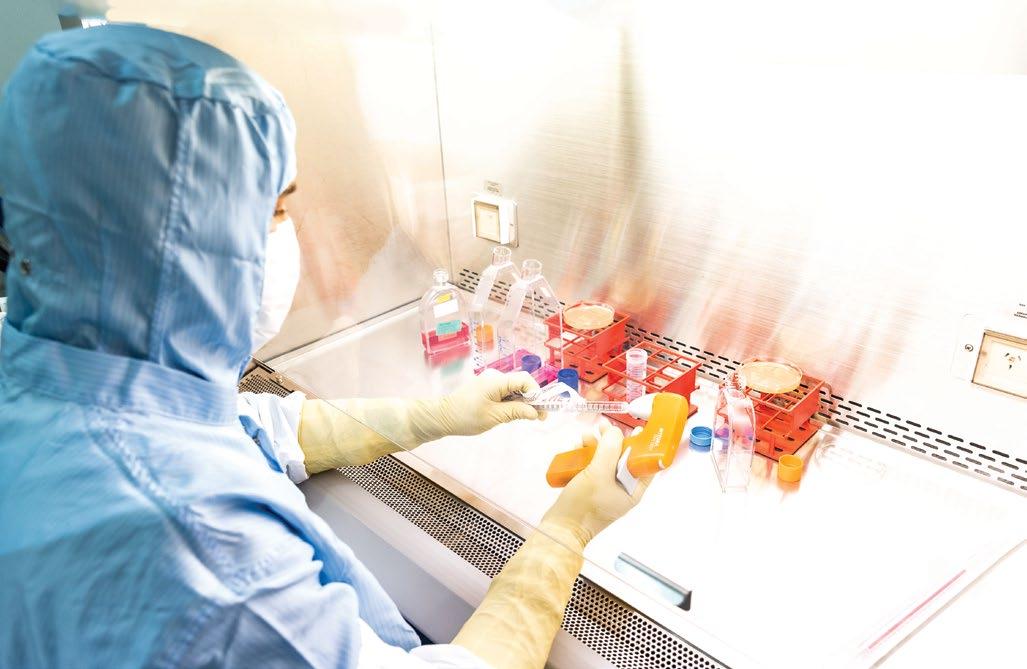
Western Australia’s unique comparative advantages in the health and medical life sciences industry have been integral to attracting capital and talent in an increasingly competitive global environment. We offer an internationally recognised research base supported by five universities, six tertiary public hospitals and 21 medical research institutes and foundations with significant entrepreneurial talent, achieving both scientific excellence and commercial success.
Western Australia’s health and medical life sciences sector is rapidly growing, with a strong presence in the manufacturing of biotechnology, pharmaceuticals, medical technology, and digital health. The Western Australian Government has committed more than $20 million to support medical manufacturing through its Investment Attraction Fund including support for the expansion of Australia’s largest contract development and manufacturer (CDMO) of sterile injectables, Novacina, and a range of other companies undertaking manufacturing.
Our manufacturing capability is complemented by a state-of-the-art clinical trials capability helping to establish a growing pipeline of new products and devices from research to manufacturing to clinical use, within increasing safety and efficacy standards.
Delivering new and advanced therapies relies on strong advanced manufacturing and the workforce to support this. Western Australia has the skills and talent to deliver cutting-edge healthcare solutions, positioning Western Australia as a leader in health innovation and patient care.
• Advancing research: accelerating research in the manufacturing of biotechnology and pharmaceuticals.
• Enterprise expansion: developing and expanding MedTech and digital health enterprises.
• Health solutions: embracing digital health to enhance healthcare delivery and access.
• Strategies:
- The Health and Medical Life Sciences Industry Strategy 2021 will position the health and medical life sciences sector in the State as a world leading, sustainable and value adding industry and improve patient and general health outcomes for Western Australians.
- The Western Australia Health and Medical Research Strategy 2023-2033 outlines the priorities and direction of health and medical research for the State.
• $1.8 billion Future Health Research and Innovation Fund providing a secure source of funding to drive health and medical research, innovation, and commercialisation to improve health and economic outcomes.
• $11 million in funding to support implementation of the Western Australia Health and Medical Life Sciences Industry Strategy over four years.
• Over $20 million investment through the Investment Attraction Fund to support medical manufacturing.
• Attraction: encouraging investor attraction, innovation, and local manufacturing of medical products and digital devices.
• Infrastructure: conducting infrastructure analysis to support early-stage businesses in prototyping and manufacturing.
Western Australia is positioned to consolidate its status as a global leader in advanced manufacturing, by building capability and amplifying capacity to foster significant growth.
Our comprehensive approach, emphasising policy, targeted initiatives, infrastructure, partnerships, and skills development, underscores our commitment.
The Western Australian Government’s vision is enacted by four pivotal focus areas:
With a clear strategy to leverage both traditional and renewable energy sources, the approach is twofold: supporting carbon-intensive industries to rapidly decarbonise and capitalising on the global energy transition towards net zero.
Emphasis on creating a diverse and highly skilled talent pipeline, ready to meet the demands of the future.
Recognising the significance of supply chain security and resilience, the focus is on fostering sovereign skills and advanced manufacturing capabilities to strengthen domestic and global critical supply chains.
Decision-making processes by investors are rapidly changing, with increasing value placed on environmental and social credentials. Recognising this, the government is ensuring that manufacturers have access to the necessary land and infrastructure to meet their evolving needs.
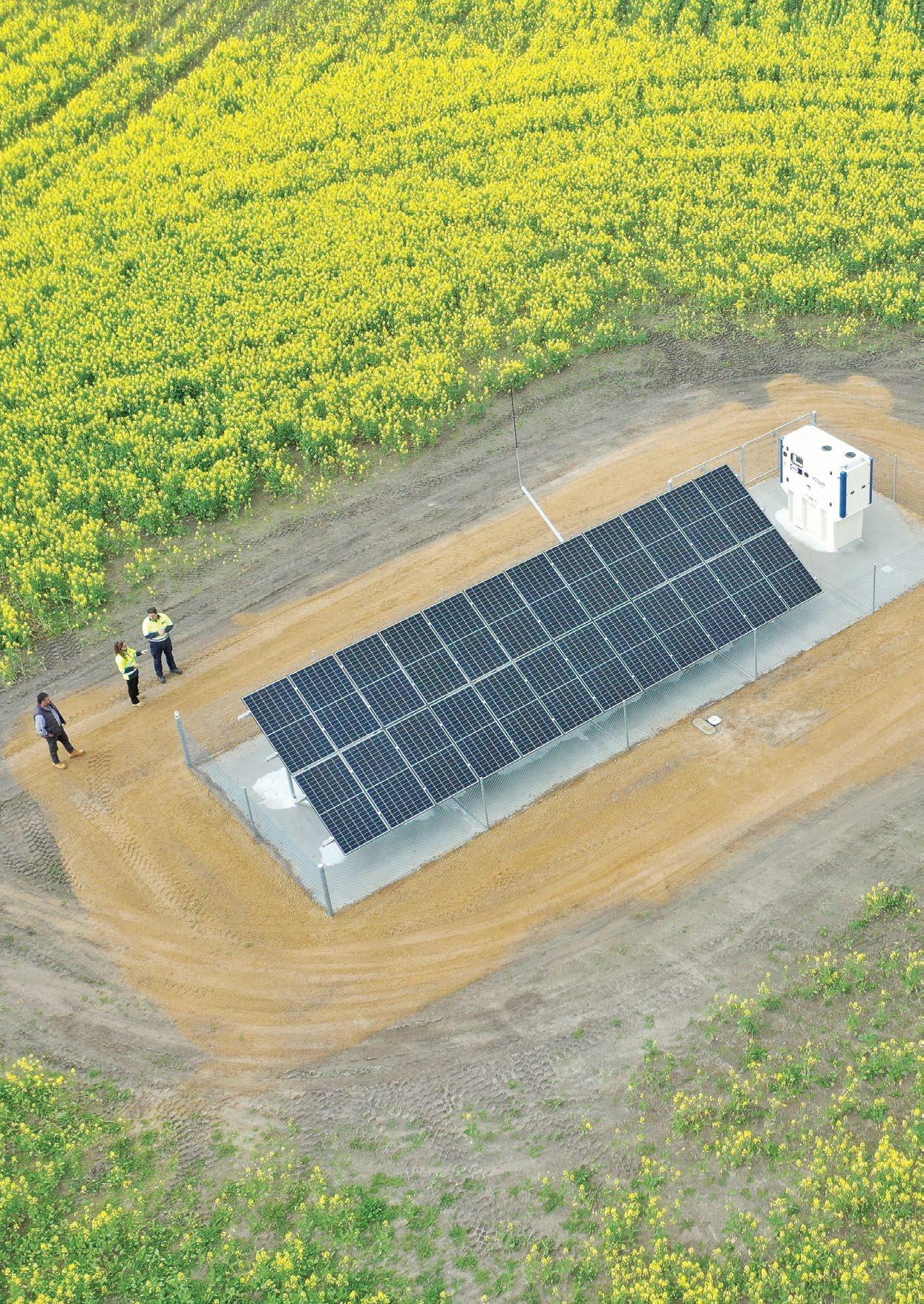
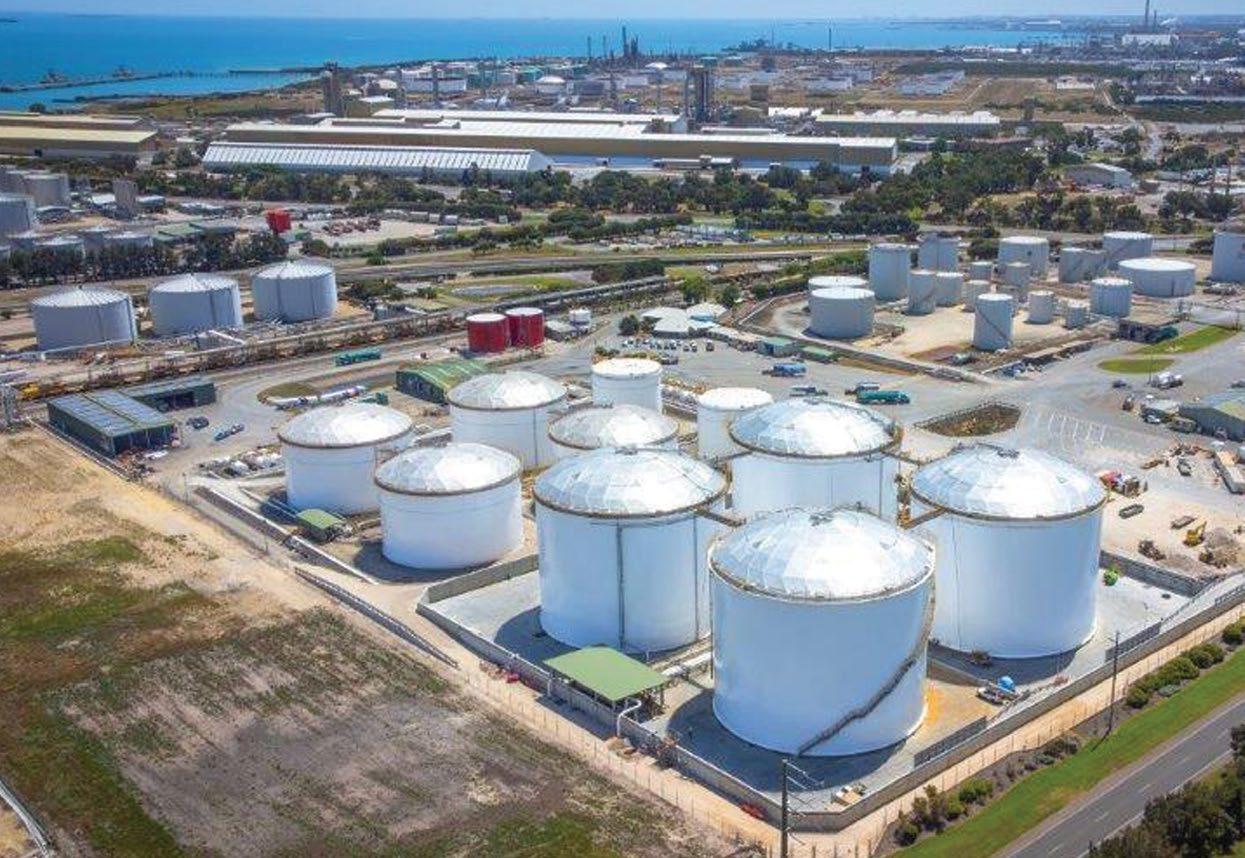
The Western Australian Government enables a thriving advanced manufacturing ecosystem by providing innovation hubs, land, infrastructure, and cross agency support. These comprise:
The Western Trade Coast is an active industrial precinct, with diverse and unique synergies that link its 4 industrial areas. An attractive location for industrial development, the Western Trade Coast possesses an integrated industrial symbiosis, where companies located in the region engage in product and biproduct exchanges and innovative collaborations. The Western Trade Coast will become even more significant with the progress of Westport, the Government’s future port located in Kwinana, and its role in unlocking further industrial development and technological innovation in the region.
SW AMTECH is a proposed initiative to strengthen the Bunbury-Geographe area’s industrial capabilities, utilising its logistical infrastructure and skilled labour to create new supply chains and access global markets, solidifying our advanced manufacturing landscape.
Supported by the Western Australian Government, AARP is a dedicated development and testing ground for automation and robotics, promising research, development, and training opportunities, and cementing our position in technological innovation.
FIPWA is a Peel-based facility that supports the development and scaling of new food products, offering resources for innovation and market testing to food manufacturers, fostering growth in the food technology sector.
The State’s GTH is a collaboration with the Chevron-operated Gorgon Project and funded by the Gorgon Joint Venture and will drive green entrepreneurship and innovation through greentech programs and ideas, incubation and acceleration.
The GTH will support and grow local emerging and established green technology businesses in support of a sustainable low carbon future.
The RCC, operated by CORE Innovation Hub and partner of the Australasian Rail Association (ARA), will provide a collaborative platform to enable manufacturing and employment opportunities in the Western Australia rail sector. It will support the assembly, manufacture, servicing, research and development of rail freight wagons to take place locally.
The WADSIH, is a collaboration with Curtin University and focuses on the application of data science and artificial intelligence to ensure the State remains at the forefront of the digital revolution.
WADSIH increases the uptake, education, training and awareness of data science through a range of services to support businesses, government and academia with building their data science capability and advancing data science projects.
The State’s first WA Creative Technology Innovation Hub, Creative Tech Village (CTV) is a collaboration with Edith Cowan University South West, and the City of Bunbury. CTV is a State-wide connector for tech creatives, both online and in person and builds local, national and international industry partnerships focusing on design, music, advertising, film and media as well as emerging development and immersive technology.
In partnership between MTPConnect, the WA Government and the University of Western Australia (UWA), the WA Life Sciences Hub was established to accelerate the growth of the state’s medical technology, biotechnology and pharmaceutical innovations. It achieves this through skills development in product translation and commercialisation, investment and access to new markets and connections.
The State-funded WA Cyber Security Innovation Hub, CyberWest, is a collaboration with Edith Cowan University Joondalup, and the City of Joondalup.
CyberWest builds State-wide capability by supporting cyber startups and scaleups to commercialise and expand.
Working across government, academia and the private sector, the hub fosters collaborations to meet local challenges and stimulate innovation to build cyber resilience, create jobs and diversify Western Australia’s economy.
Western Australia is dedicated to a future where growth is not only robust but also sustainable, inclusive, and environmentally responsible. This commitment is reflected in our strategic approach to intertwining green practices with our industrial ambitions, ensuring our economic expansion harmonises with environmental stewardship.
Every initiative within Western Australia, from sourcing materials to final production, is viewed through the lens of sustainability and a circular economy. From waste reduction to energy-efficient practices, our holistic approach ensures that our advanced manufacturing endeavours are ecofriendly, resource-efficient, and future-ready.
The global urgency to combat climate change resonates deeply within Western Australia’s manufacturing corridors. With policies that support the adoption of renewable energy and promote carbon capture, we are on track to achieve our net zero emissions target by 2050.
Our workforce, renowned for constructing some of the most significant resources infrastructure, is the embodiment of adaptability and innovation. This dedication to innovation has established Western Australia as a leader in autonomous mining, a testament to our global influence in this sector. With ongoing training initiatives and strong partnerships with academic entities and the Vocational Education and Training (VET) sector, we ensure our workforce is ready for the challenges of today and tomorrow.
In an era marked by digital transformation, Western Australia’s educational institutions are at the vanguard, fostering expertise in science, technology, engineering and mathematics (STEM) to cultivate a digitally proficient workforce for emerging industries. Our universities are nurturing talent in fields ranging from cyber security to industrial automation, while our innovation hubs and research centres foster a collaborative environment, where business, industry, and academia converge to drive digital sector skills and industry growth.
In an ever-evolving manufacturing world, Western Australia prioritises continuous learning, fostering partnerships with academic institutions and industry leaders for knowledge and innovation.
A partnership between the Australian Government and Western Australian Government has enabled the introduction of the Fee Free initiative in 2023. Under this program more than 130 full qualifications and skill sets have been made Fee Free, with the Western Australian Government funding additional places to keep pace with demand. In 2023, there were more than 39,500 enrolments in fee free TAFE courses and skill sets in Western Australia. As part of the National Skills Agreement, the Western Australian and Australian Governments have agreed to extend Fee Free training until the end of 2026.
Running in parallel to the Fee Free program, Lower Fees, Local Skills, has reduced the fees of high priority courses by up to 72 percent, including technology and digital. The Lower Fees, Local Skills initiative attracted almost 60,000 enrolments in low-fee courses in 2023 and is continuing to provide access to 160 heavily discounted courses. Targeted at boosting skills development in priority areas, these initiatives are helping to skill more Western Australians in areas important to our economy and grow the supply of skilled workers needed to meet the demands of our State’s critical and emerging industries.
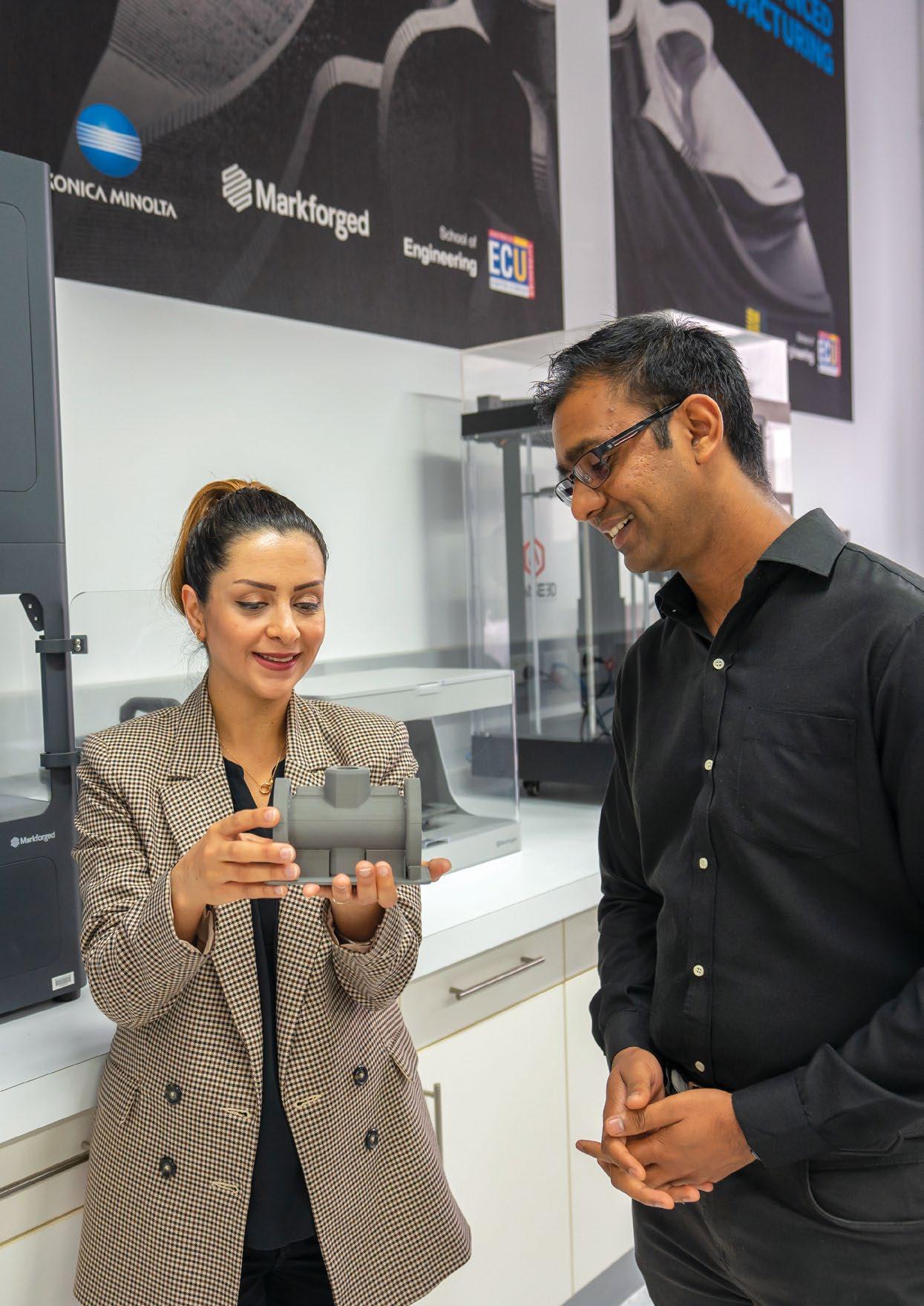 CREDIT: Edith Cowan University
CREDIT: Edith Cowan University
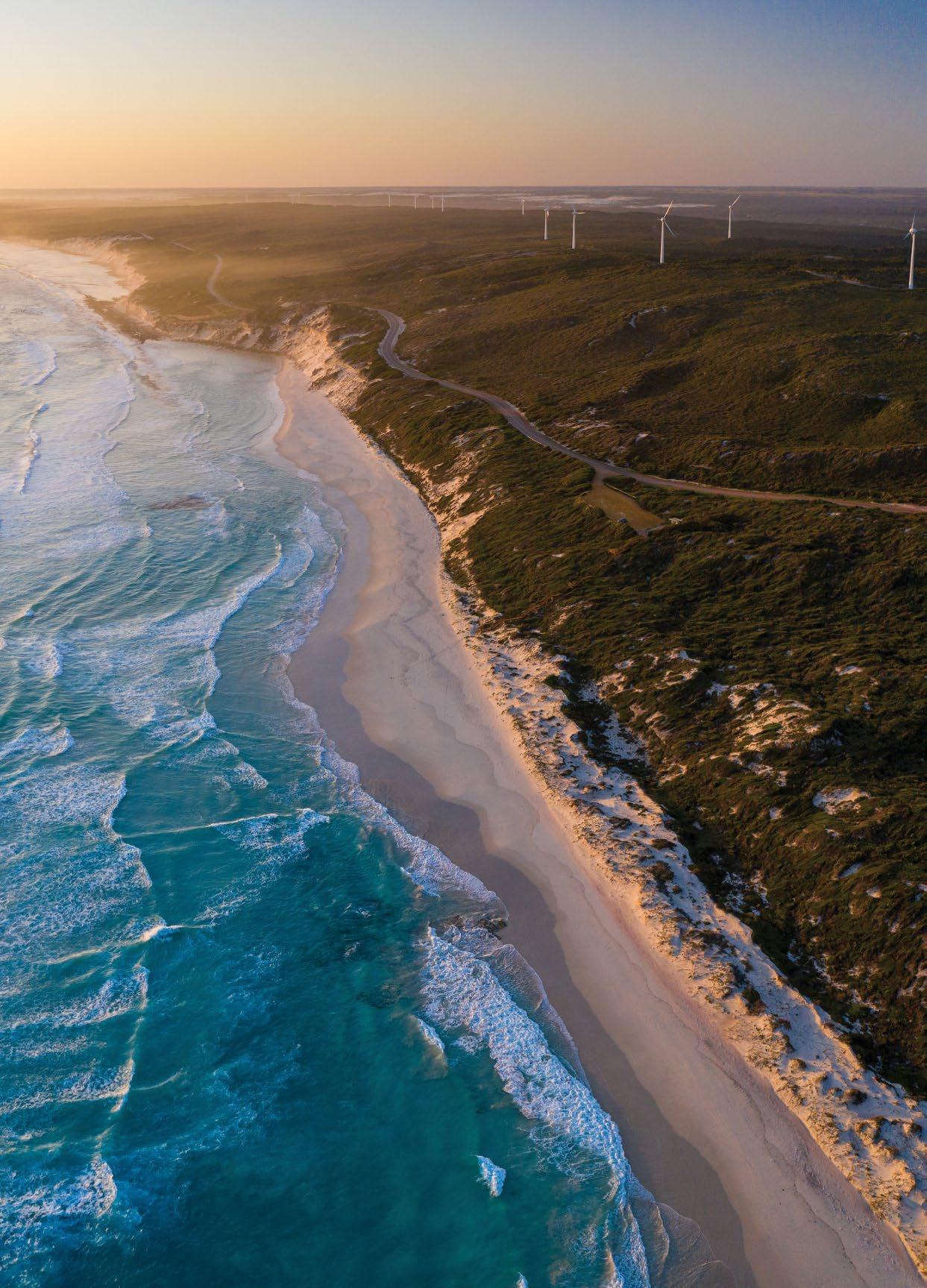 Nine Mile Beach, Great Ocean Drive
CREDIT: Tourism WA
Nine Mile Beach, Great Ocean Drive
CREDIT: Tourism WA
Western Australia is not just a hub for advanced manufacturing; it’s a haven for those seeking a balanced life.
Beyond factories and innovation hubs, Western Australia offers a quality of life that’s unparalleled. With its pristine beaches, vibrant culture, and world-class amenities, it’s a place where work and relaxation go hand-in-hand.
Perth, our capital city, ranks among the top 10 most liveable cities globally. As the country’s most multicultural society, we embrace diversity, offering a blend of traditions and modernity. Our booming economy presents ample opportunities for businesses and individuals alike.
With affordable housing, quality healthcare and a strong and resilient economy, Western Australia promises a future that’s not just prosperous but enriching. Our State offers secure, quality manufacturing job opportunities.
Western Australia is an ideal destination for students, offering world-class education.
We offer a variety of academic and social opportunities and a friendly multi-cultural community.
Strategically positioned with direct links to the bustling Asia Pacific region, our international connectivity is unmatched, with low latency digital infrastructure and key trade routes converging in our State.
Western Australia boasts a cost-competitive environment for businesses, particularly in housing and infrastructure, and sharing a time zone with economic powerhouses such as China, Japan, South Korea, and Indonesia, opening the door to international markets and round-theclock productivity.
In Western Australia, life flourishes amidst a strong job market, supported by affordable living and a wealth of land ready for innovation and development. Join us, and be part of a community that’s crafting the future, one innovation at a time.
The Western Australian Government will make your entry into Western Australia as seamless as possible, and actively support efforts to accelerate the development of industry to meet its goals. With an extensive network of local and international offices, the Department of Jobs, Tourism, Science and Innovation are positioned to guide you through the intricacies of manufacturing and investment in Western Australia.
We can help with:
• Advice on business support such as grants, funding and incentives available for the sector.
• Facilitation services to help you navigate our project approvals process efficiently and effectively.
• Access to relevant and timely market intelligence to assist you to inform your strategy or business plan.
• Identification and facilitation of access to industrial land and assistance with site visits.
• Identification of relevant public and private contacts to assist with your enquiries.
• A dedicated point of contact for your business or project.
• A guide to working in Western Australia (business registration, property, visas, banking, employment standards and Australian tax) to accelerate investment.
Interested in exploring what Western Australia has to offer?
Our dedicated team is here to guide you every step of the way. For more information on how we can help contact us at investandtrade@jtsi.wa.gov.au

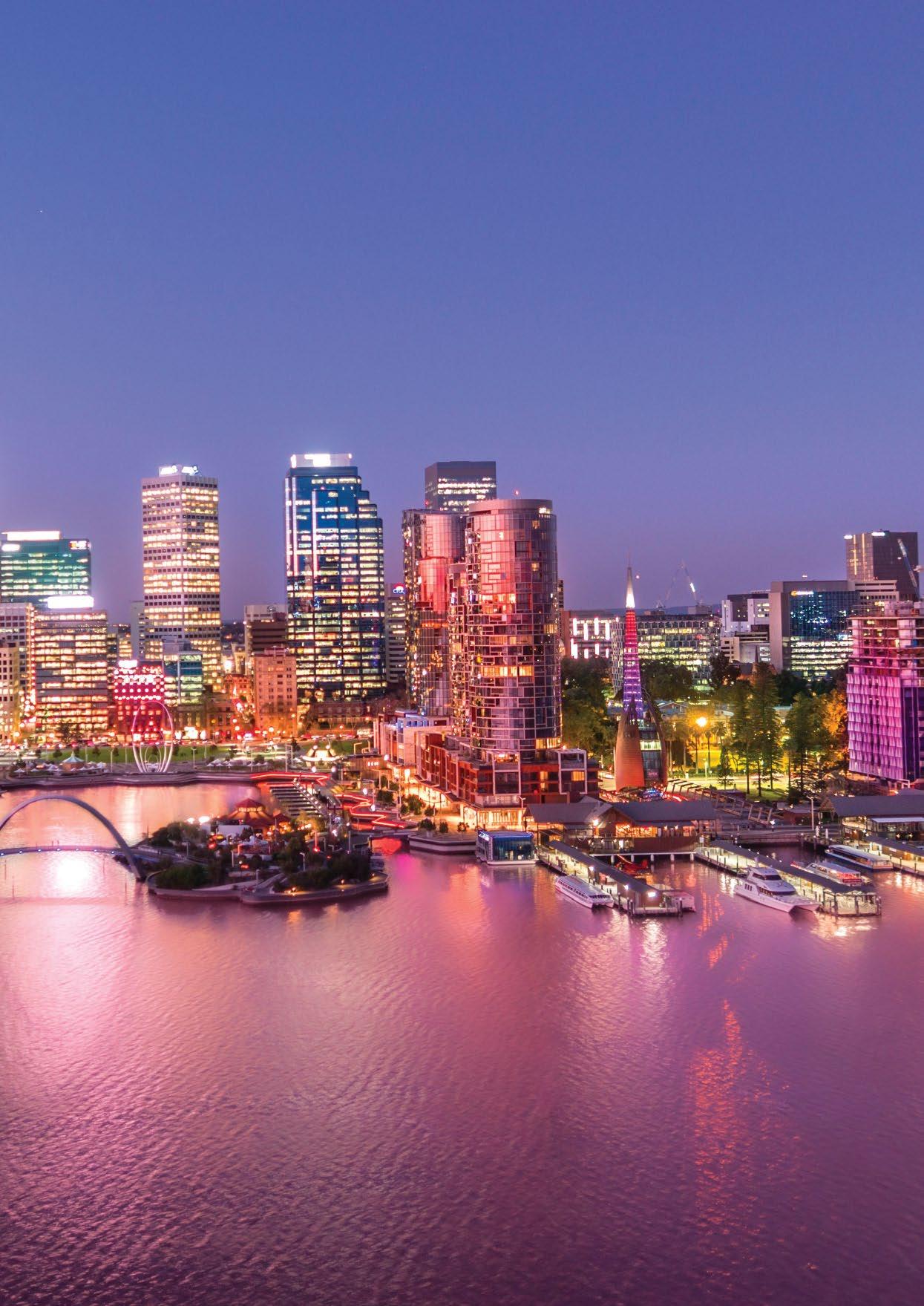 Elizabeth Quay Perth
CREDIT: Tourism WA
Elizabeth Quay Perth
CREDIT: Tourism WA